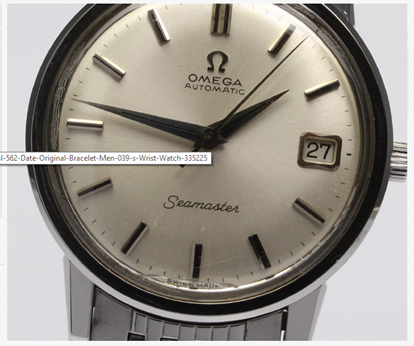AllamaJJoyce
·Dear Knowledgeable Folks,
I am just starting my watch collecting journey, so forgive my naivety and ignorance. As a first mechanical watch, I am looking into possibly buying a vintage Omega (Constellation or Seamaster) and have a generic question regarding how to judge the authenticity of a timepiece.
I am aware of and have read the various guides available here and elsewhere on the internet but have some general questions which remain unanswered.
Assuming, the movement is genuine for the time being, the most important aspect when judging the authenticity, and hence the value, of a particular watch is said to be the dial. In lieu of this logic, I have been comparing the various Omegas I have found on the internet with the official Omega Vintage resource to evaluate, through pictures and descriptions, aspects of the watch which may help me determine whether a particular piece is original, redialled or a frankenwatch.
My questions specifically pertain to the level of detail one must go into in establishing whether a piece is original when the reference number is either unavailable or incorrect, given the calibre number. Just to clarify, I sift through the various references found using the particular calibre and try to match the watch being sold with the one on the Omega Vintage database:
1. Should the model have exactly the same hands (i.e. “Dauphine”, “Stick”, etc.) or is it possible that a particular reference was made using different hands? Or is it also possible that different hands were installed during servicing of the watch by Omega due to a multitude of reasons? Same applies to hour markers.
I have also noted that sometimes the hands on the pictures included on the Omega Vintage database do not match the description of the hands given on it (e.g., https://www.omegawatches.com/planet-omega/heritage/vintage-details/14940/).
2. When looking at a Seamasters, the “S” of the “Seamaster” written on the dial face, should be exactly as on the picture on Omega Vintage database (compare pictures B and C)? Or were different fonts used for the “S” on the same reference?
3. When looking at crosshair dials, are there cases where non-crosshair and crosshair dials were produced for the same reference? Or would a crosshair dial have its own unique reference number?
Below are a series of pictures to better illustrate the crux of my questions:
Ebay:
Movement 562
Cross-hair Dial and Dauphine Hands with Riveted Hour Markers
The closest reference I found was 166.0003 (https://www.omegawatches.com/planet-omega/heritage/vintage-details/14477/). Please note that on the database this reference does not have a cross-hair dial and has the elongated "S" with straight lines. Is the one on ebay authentic?
I found another watch online which seems to fit the ref. 166.0003, without the added cross-hair, however, the "S" of the "Seamaster" is once more the smooth curved "S" rather than the elongated one shown on the Omega Vintage Database. Does that mean it has been redialed?
I am just starting my watch collecting journey, so forgive my naivety and ignorance. As a first mechanical watch, I am looking into possibly buying a vintage Omega (Constellation or Seamaster) and have a generic question regarding how to judge the authenticity of a timepiece.
I am aware of and have read the various guides available here and elsewhere on the internet but have some general questions which remain unanswered.
Assuming, the movement is genuine for the time being, the most important aspect when judging the authenticity, and hence the value, of a particular watch is said to be the dial. In lieu of this logic, I have been comparing the various Omegas I have found on the internet with the official Omega Vintage resource to evaluate, through pictures and descriptions, aspects of the watch which may help me determine whether a particular piece is original, redialled or a frankenwatch.
My questions specifically pertain to the level of detail one must go into in establishing whether a piece is original when the reference number is either unavailable or incorrect, given the calibre number. Just to clarify, I sift through the various references found using the particular calibre and try to match the watch being sold with the one on the Omega Vintage database:
1. Should the model have exactly the same hands (i.e. “Dauphine”, “Stick”, etc.) or is it possible that a particular reference was made using different hands? Or is it also possible that different hands were installed during servicing of the watch by Omega due to a multitude of reasons? Same applies to hour markers.
I have also noted that sometimes the hands on the pictures included on the Omega Vintage database do not match the description of the hands given on it (e.g., https://www.omegawatches.com/planet-omega/heritage/vintage-details/14940/).
2. When looking at a Seamasters, the “S” of the “Seamaster” written on the dial face, should be exactly as on the picture on Omega Vintage database (compare pictures B and C)? Or were different fonts used for the “S” on the same reference?
3. When looking at crosshair dials, are there cases where non-crosshair and crosshair dials were produced for the same reference? Or would a crosshair dial have its own unique reference number?
Below are a series of pictures to better illustrate the crux of my questions:
Ebay:
Movement 562
Cross-hair Dial and Dauphine Hands with Riveted Hour Markers
The closest reference I found was 166.0003 (https://www.omegawatches.com/planet-omega/heritage/vintage-details/14477/). Please note that on the database this reference does not have a cross-hair dial and has the elongated "S" with straight lines. Is the one on ebay authentic?
I found another watch online which seems to fit the ref. 166.0003, without the added cross-hair, however, the "S" of the "Seamaster" is once more the smooth curved "S" rather than the elongated one shown on the Omega Vintage Database. Does that mean it has been redialed?


